Customize Your Multidimensional Quotes
Learning Objectives
After completing this unit, you’ll be able to:
- Change which MDQ fields appear in the Quote Line Editor.
- Control the date of the break between first and second MDQ segments.
- Set up support for custom MDQ segment lengths.
- Attach one-time prices with overridden properties to MDQ products.
Customize the MDQ Layout
As you saw in the previous unit, when you add an MDQ product to a quote, CPQ puts it into a special interface that has fields in a column layout. As an admin, it’s easy to change which fields are included. Let’s add the End Date field to the layout so that it appears right below Start Date.
- Click
 and click Setup. The Setup page opens in a new tab.
and click Setup. The Setup page opens in a new tab. - Click Object Manager.
- Click Quote Line.
- Click Field Sets.
- Click Segmented Line Editor.
- Drag End Date into the gray box, just below Start Date.

- Click Save.
Close the Setup tab to get back to the Salesforce CPQ tab.
And there you go; now End Date appears in the column of fields for every segment. Nice work!

It’s also possible to place extra fields into the header row of the MDQ product. The screenshot below shows Product Family added after the Product Name field.

To add fields into the MDQ header, update the Segmented Line Editor Summary field set in the same way you added the end date field above. Just be aware that these fields can’t be edited in the Quote Line Editor—they are for informational purposes only.
Accounting for Partial Segments
In the MDQ examples so far, we’ve had perfectly sized subscription terms so that each segment was a full year. In the real world, you sometimes need to sell subscriptions that have odd lengths like 18 months. So, how does CPQ break 18 months into two segments?
By default, CPQ puts full segments first and the partial segment at the end. In this screenshot, an 18 month subscription that starts January 1 gets a shorter segment for year 2.

Sometimes customers don’t want the partial segment to appear at the end. Maybe they’re trying to buy a subscription that coincides with existing service that renews July 1, not January 1. In that example, the partial segment would work best in the front.
Thankfully CPQ gives sales reps a way to control where breaks in subscription segments fall. The field named First Segment Term End Date is a mouthful, but it’s how you can shift breakpoints for MDQ subscriptions. This quote-level field tells CPQ where the first segment should end, which affects all subsequent segments. In the above example where the customer wants the full segment to begin July 1, the sales rep would set First Segment Term End Date to June 30.
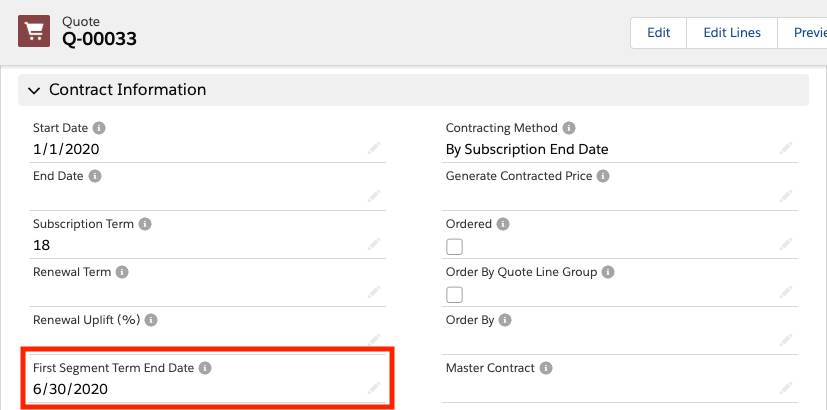
Notice how it affects the end date of the first segment below, and the start date of the second segment.

Custom Segments
You may remember seeing a field on the Price Dimension record named Type when you set up the VPN License product to support MDQ. You left it as “Year” then, which forced CPQ to create year-long segments. But what if you want to give your sales reps the option of setting their own segment lengths, such as 6 months? You can do that by setting the Type field to Custom.
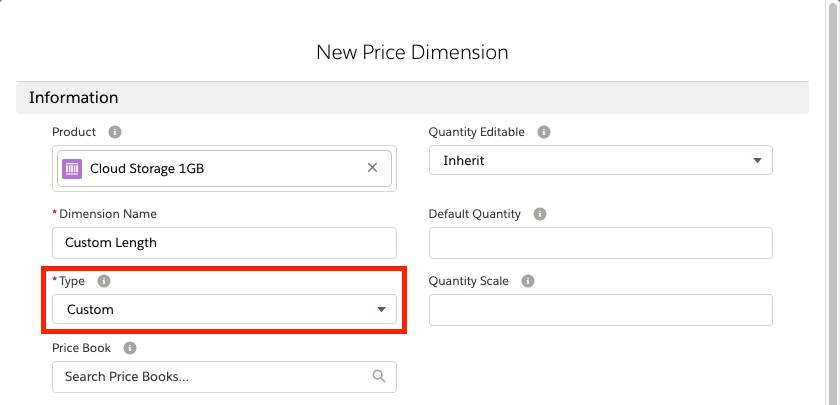
MDQ products set to Custom appear differently on the Quote Line Editor. They get their own tab in the segmented products section.

This tab has a pencil icon next to it, which opens an overlay. Here you define the start and end dates for the first segment, add other segments to cover the remainder of the subscription term, and label each segment how you want it to appear on the proposal. In this example, the customer wants fewer licenses during a 3-month “beta testing” phase, then more licenses after the feature launches for the remainder of the 2-year term.
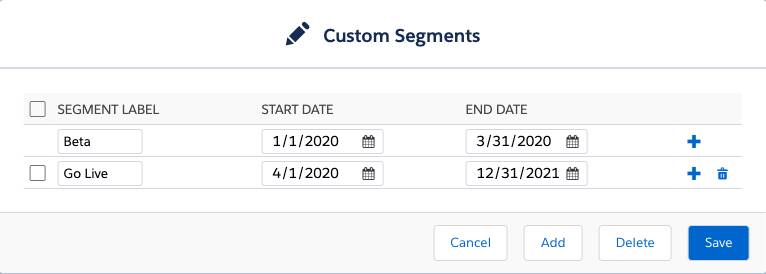
By default, CPQ does not allow gaps in custom segments. For example, if you try to start the second segment a month after the first ends, you receive an error message.
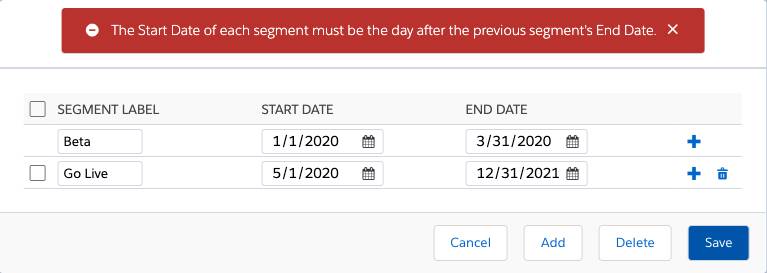
If you ever want your sales reps to have the option to include subscription gaps, you must navigate to Setup > Installed Packages > Configure (for Salesforce CPQ) > Pricing and Calculation tab, and change the Allow Non-Consecutive Custom Segments setting to true. It's worth noting that CPQ never allows for overlapping dates while editing custom segments.
Lastly, regardless of this package setting, be aware that sales reps can edit the start and end dates of custom segments if the fields are included in the layout.

Currently, editing the dates here does NOT produce a validation message if gaps or overlaps exist, even if you don’t allow nonconsecutive custom segments. If this is a concern, either remove the date fields from the layout, or create your own validation rule to check for gaps and overlaps.
One-time Price Dimensions
While MDQ is mainly used to split a subscription into pieces, it has one more trick to offer. Imagine that anytime you sell a VPN License, there’s a one-time $20 setup fee for the customer regardless of subscription length, and this fee can’t be discounted. You can do that and more using MDQ one-time price dimensions.
To see one-time price dimensions in action, let’s update the VPN License to meet the new requirements. You start by navigating to the VPN License product.
- Click Products in the navigation bar.
- Click VPN License.
- Click the Related tab.
- In the Price Dimensions related list, click New.
- For Dimension Name, enter
Activation. - For Type, choose One-time.
You can create as many one-time price dimensions as you’d like, but only after a time-based price dimension exists. - For Unit Price, enter
20.
This overrides the price book price for this segment. If your org uses multiple currencies, you have to re-create this one-time dimension for each currency. - For Non Discountable, choose Yes.
This is how you override the discounting behavior that’s defined on the product record. As you can see, there are a number of other things we can override, but for now we’ll let everything else just inherit from the product record.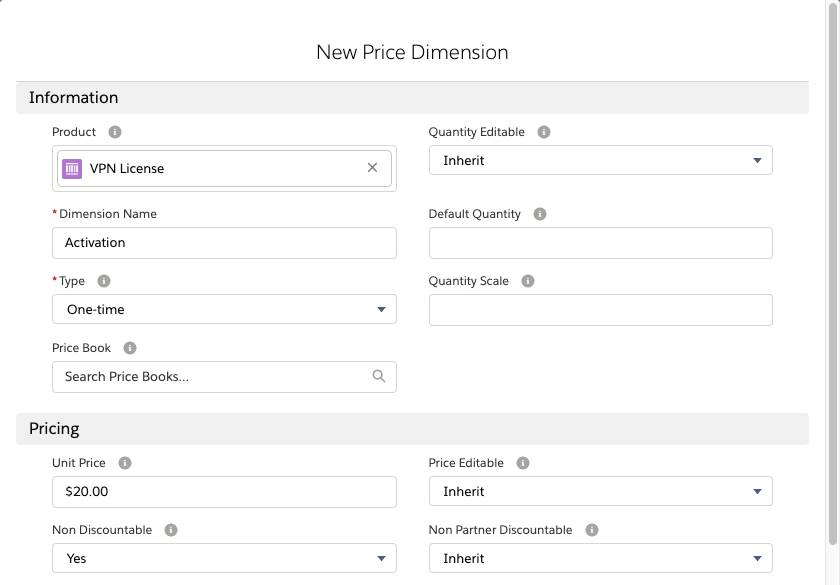
- Click Save.
Great, now that the setup is done, let’s see what it looks like in the Quote Line Editor by adding VPN License to a premade quote.
- Click Quotes in the navigation bar, then choose the All list view.
- Click Q-00035.
- Click Edit Lines.
- Click Add Products.
- Check VPN License.
- Click Select.
Since this quote has a subscription term of 24 months, we see three columns: Activation, Year 1, and Year 2. The Activation price is your custom defined $20, and isn’t prorated since it’s not related to the length of the subscription. If you expand the MDQ section and mouse-over the Additional Discount field, you’ll see the padlock icon appear. No discounting this segment!
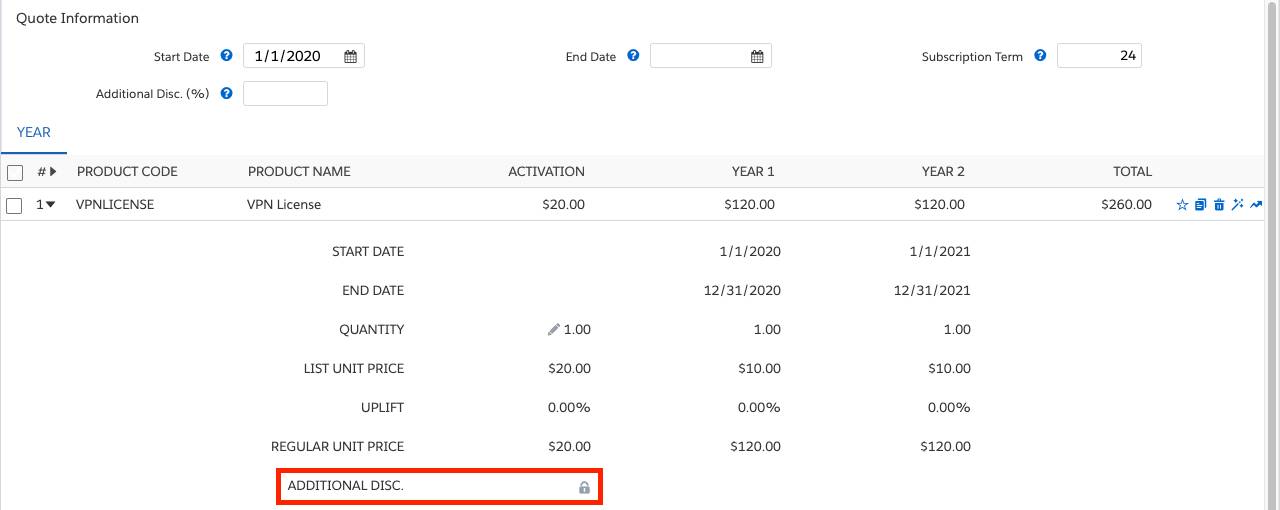
Finally, as you might guess, one-time segments get their own quote line records, just like other MDQ segments.
MDQ gives you a lot of options for selling subscriptions in pieces, while providing a nice user interface to keep things tidy. Your sales reps and your customers will appreciate MDQ’s flexibility.